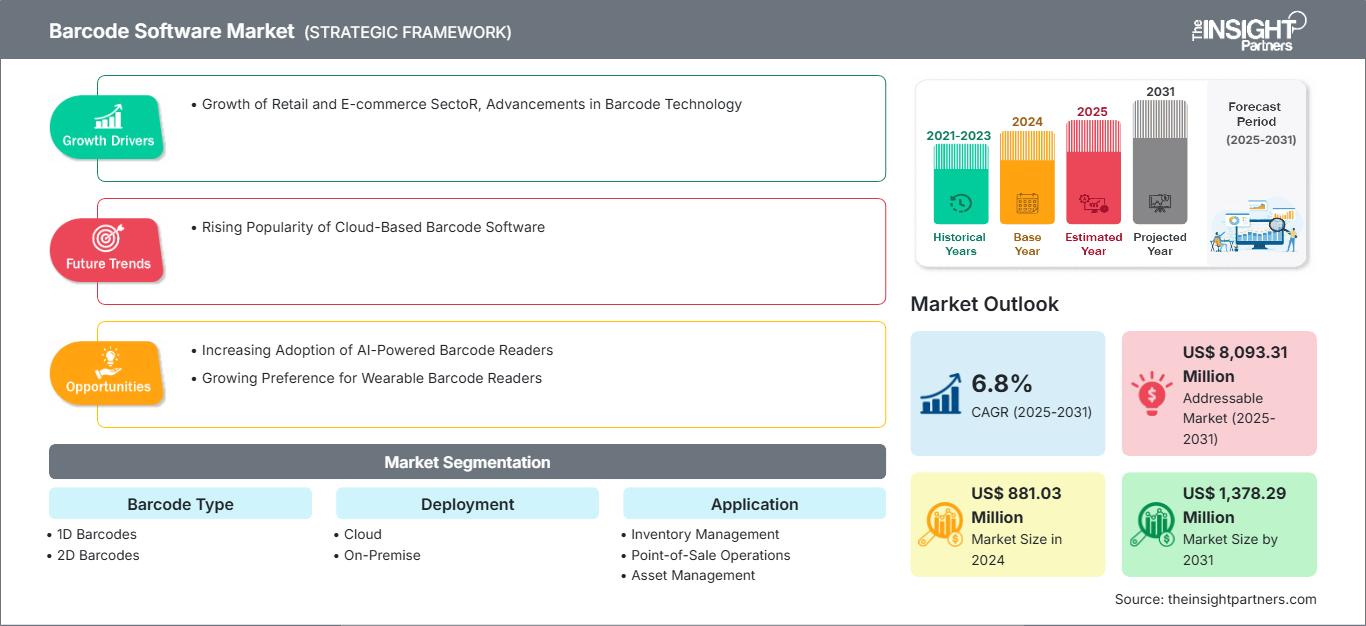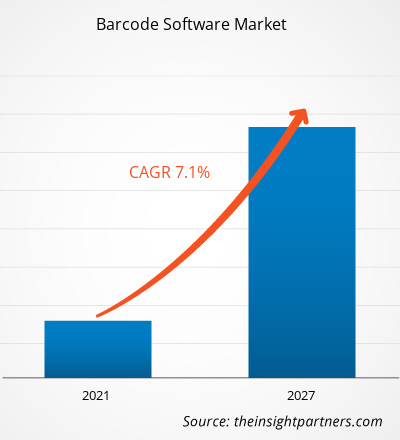바코드 소프트웨어 시장 규모는 2024년 8억 8,103만 달러로 평가되었으며, 2031년에는 13억 7,829만 달러에 이를 것으로 예상됩니다. 2025년부터 2031년까지 연평균 성장률(CAGR) 6.8%를 기록할 것으로 예상됩니다. 클라우드 기반 바코드 소프트웨어의 인기 증가는 주요 시장 동향이 될 것으로 예상됩니다.
바코드 소프트웨어 시장 분석
바코드 소프트웨어는 데스크톱 시스템, 모바일 기기, 클라우드 기반 환경 등 다양한 플랫폼을 지원하여 다양한 조직의 고유한 요구에 맞춰 유연하게 대응할 수 있습니다. 소매 및 전자상거래 부문의 성장과 바코드 기술의 발전과 같은 요인들이 바코드 소프트웨어 시장을 주도하고 있습니다. AI 기반 바코드 판독기 도입 증가와 웨어러블 바코드 판독기에 대한 선호도 증가로 인해 바코드 소프트웨어 시장은 예측 기간 동안 성장할 것으로 예상됩니다. 클라우드 기반 바코드 소프트웨어의 인기 상승은 바코드 소프트웨어 시장의 주요 트렌드가 될 것으로 예상됩니다. 그러나 스캐너 의존도는 바코드 소프트웨어 시장 성장을 저해할 수 있습니다.
바코드 소프트웨어 시장 개요
바코드 소프트웨어는 바코드를 생성, 인쇄 및 관리하기 위해 특별히 개발된 애플리케이션을 포함합니다. 바코드는 다양한 너비의 평행 막대 또는 선으로 구성된 기계 판독 코드로, 데이터를 나타냅니다. 이 소프트웨어를 통해 사용자는 바코드 이미지 또는 라벨을 생성하여 바코드 스캐너나 모바일 기기로 스캔하고 디코딩할 수 있습니다. 다른 비즈니스 시스템과 통합되고 다양한 플랫폼을 지원하여 원활한 데이터 교환을 촉진하고 전반적인 운영 효율성을 향상시킵니다. 바코드 소프트웨어는 재고 관리, 제품 추적, POS 시스템, 공급망 관리 등 다양한 산업 분야에서 널리 사용됩니다. 바코드 소프트웨어는 재고 추적부터 제품 라벨링까지 다양한 애플리케이션의 바코드 생성, 인쇄 및 관리를 용이하게 합니다. 인기 있는 옵션으로는 BarTender와 ZebraDesigner가 있으며, 라벨 디자인, 시스템 통합, 확장성 등의 기능을 제공합니다. 이 소프트웨어는 다른 비즈니스 시스템과 원활하게 통합되어 플랫폼 간 원활한 데이터 교환을 보장합니다. 이러한 통합은 실시간 업데이트, 인적 오류 최소화, 재고 추적 및 관리의 정확성을 보장하여 전반적인 운영 효율성을 향상시킵니다.
요구 사항에 맞게 이 보고서를 사용자 정의하십시오.
이 보고서의 일부, 국가 수준 분석, Excel 데이터 팩을 포함하여 모든 보고서에 대한 사용자 정의를 무료로 받을 수 있을 뿐만 아니라 스타트업 및 대학을 위한 훌륭한 제안 및 할인을 이용할 수 있습니다
바코드 소프트웨어 시장: 전략적 통찰력

-
이 보고서의 주요 주요 시장 동향을 확인하세요.이 무료 샘플에는 시장 동향부터 추정 및 예측에 이르기까지 데이터 분석이 포함됩니다.
바코드 소프트웨어 시장 성장 요인 및 기회
소매 및 전자상거래 부문의 성장
국제무역청(ITA)에 따르면, 2026년까지 글로벌 B2B 전자상거래 시장은 무려 36조 달러에 이를 것으로 예상되며, 이는 이 부문의 엄청난 규모와 잠재력을 보여줍니다. 마찬가지로 2025년 2월, 미국 상무부 인구조사국은 2024년 4분기 미국 소매 전자상거래 매출 추산치를 발표했습니다. 2024년 4분기에 전자상거래 매출은 총 소매 매출의 16.4%를 차지하여 3,529억 달러에 달했으며, 2024년 3분기 대비 22.1% 증가했습니다. 2023년 4분기와 비교했을 때 전자상거래 매출은 9.3% 성장했고, 총 소매 매출은 4.5% 증가했습니다. 2024년 전체 전자상거래 매출은 1조 1,926억 달러에 달할 것으로 추산되며, 2023년 대비 8.1% 성장했습니다. 전 세계적으로 소매 및 전자상거래 부문의 급속한 성장으로 효율적인 재고 및 공급망 관리 시스템에 대한 필요성이 커지고 있습니다. 바코드 소프트웨어를 사용하면 기업에서 재고 관리를 개선하고, 실시간으로 제품 이동을 추적하고, 더 나은 고객 서비스를 제공할 수 있습니다. 전자상거래가 성장함에 따라 정확한 주문 처리를 위해 바코드 스캐닝 및 추적 소프트웨어의 필요성이 더욱 중요해지고 있습니다. 따라서 소매 및 전자상거래 부문의 성장은 바코드 소프트웨어 시장을 견인하고 있습니다.
AI 기반 바코드 리더기 도입 증가
바코드 소프트웨어 시장은 기술 발전과 다양한 제조 부문의 자동화 및 효율성에 대한 수요 증가에 힘입어 상당한 성장을 경험하고 있습니다. 이러한 고급 바코드 리더기의 출시는 바코드 소프트웨어 시장에서 AI 기반 솔루션 도입이 증가하고 있음을 시사합니다. 예를 들어, 2025년 1월, 산업용 머신 비전 분야의 글로벌 선두 기업인 코그넥스(Cognex Corporation)는 최신 제품인 DataMan 290 및 390 바코드 리더기를 출시하며 이 분야의 혁신을 지속적으로 주도해 왔습니다. 이 신제품들은 최첨단 AI 기술을 활용하여 탁월한 디코딩 정확도와 신뢰성을 제공하여 운영 생산성 향상에 필수적인 도구로 자리매김했습니다. 이러한 고급 리더기의 출시는 복잡한 바코드 스캐닝 문제를 해결할 뿐만 아니라, 진화하는 바코드 소프트웨어 시장에서 수많은 기회를 창출합니다. 코그넥스의 DataMan 290 및 390 바코드 리더기는 산업용 스캐닝 기술의 획기적인 도약입니다. 첨단 AI를 기반으로 하는 이 리더기는 다양한 바코드 유형과 제조 환경에서 고성능 디코딩을 보장합니다. AI 통합을 통해 장치는 다양한 스캐닝 조건을 학습하고 적응하여 대비가 낮거나 손상되었거나 인쇄 품질이 좋지 않은 바코드와 같은 까다로운 조건에서도 실시간으로 정확도와 속도를 향상시킵니다. 이러한 혁신은 제조업체에 효율성을 높이고 가동 중단 시간을 최소화하는 다재다능한 솔루션을 제공합니다.
바코드 소프트웨어 시장 보고서 세분화 분석
바코드 소프트웨어 시장 분석 도출에 기여한 주요 분야는 배포, 바코드 유형, 애플리케이션, 최종 사용 산업입니다.
- 배포 측면에서 바코드 소프트웨어 시장은 온프레미스와 클라우드로 구분됩니다. 클라우드 부문이 2024년 시장을 장악했습니다.
- 바코드 유형을 기준으로 시장은 1D 바코드와 2D 바코드로 구분됩니다. 1D 바코드 부문이 2024년 시장을 장악했습니다.
- 응용 프로그램 측면에서 시장은 재고 관리, POS(판매 시점 관리) 운영, 자산 관리, 직원 출석 및 근무 시간 추적 등으로 구분됩니다. 재고 관리 부문이 2024년 시장을 장악했습니다.
- 최종 사용 산업을 기준으로 바코드 소프트웨어 시장은 BFSI, 운송 및 물류, 제조, 의료, 소매 및 전자상거래 등으로 구분됩니다. 소매 및 전자상거래 부문이 2024년 시장을 장악했습니다.
지역별 바코드 소프트웨어 시장 점유율 분석
- 바코드 소프트웨어 시장은 북미, 유럽, 아시아 태평양(APAC), 중동 및 기타의 5개 주요 지역으로 구분됩니다. 아프리카(MEA), 남미 및 중미 지역이 포함됩니다. 북미는 2024년 시장을 장악했으며, 그 뒤를 유럽과 아시아 태평양 지역이 따릅니다.
- 북미 지역은 최첨단 기술의 조기 도입, 주요 시장 참여자들의 강력한 입지, 그리고 물류, 소매 및 재고 관리 자동화에 대한 수요 덕분에 글로벌 바코드 소프트웨어 시장에서 지배적인 위치를 차지하고 있습니다. 이 지역은 스마트 제조 및 전자상거래에 대한 투자와 더불어 탄탄한 인프라를 갖추고 있습니다. 또한, The Enterprise World에 따르면 미국은 전 세계 QR 코드 사용에서 선두를 달리고 있으며, 2022년 전 세계 스캔의 42.2%를 차지했고, 이 점유율은 2023년에는 43.9%로 상승했습니다.
- 유럽의 바코드 소프트웨어 시장은 자동차, 가전제품, 제약과 같은 산업을 중심으로 이 지역의 강력한 제조 기반을 바탕으로 꾸준히 성장하고 있습니다. 재고 관리, 공급망 최적화 및 규정 준수를 위한 바코드 솔루션 도입이 이 지역에서 크게 증가하고 있습니다. 또한, 인더스트리 4.0과 유럽 제조업의 디지털화 추세가 확대되면서 바코드 소프트웨어 솔루션에 대한 수요가 증가하고 있습니다. 아시아 태평양 지역은 바코드 소프트웨어 시장에서 가장 높은 성장률을 기록할 것으로 예상됩니다. 이러한 성장세는 중국과 인도 등 신흥 경제국의 급속한 산업화에 힘입어 소매, 물류, 제조 분야에서 바코드 소프트웨어 도입이 증가하고 있습니다. 아시아 태평양 지역에서는 자동화, 스마트 물류, 그리고 전자상거래 플랫폼 개발에 대한 관심이 꾸준히 증가하고 있습니다. 또한, 식음료, 소매, 의료 분야에서 바코드 기반 솔루션에 대한 수요도 증가하고 있습니다. VISA에 따르면 2022년 동남아시아 소비자의 93%가 QR 코드를 포함한 다양한 비현금 결제 수단을 사용하여 거래했습니다. 효율적인 디지털 결제 솔루션에 대한 수요가 이 지역에서 증가하고 있으며, 이는 기술 발전과 시장 확대를 촉진하고 있습니다.
바코드 소프트웨어 시장 보고서 범위
바코드 소프트웨어 시장 뉴스 및 최근 동향
바코드 소프트웨어 시장은 1차 및 2차 조사 이후 주요 기업 간행물, 협회 데이터, 데이터베이스 등 정성적 및 정량적 데이터를 수집하여 평가합니다. 바코드 소프트웨어 시장의 몇 가지 동향은 다음과 같습니다.
- Honeywell(Nasdaq: HON)은 자사의 SwiftDecoder 바코드 디코딩 소프트웨어가 Corvus Robotics의 자율 비행 재고 드론에 통합될 것이라고 발표했습니다. 이 선구적인 솔루션은 창고 및 유통 센터(DC)에서 사용되어 소매업체, 유통업체, 제조업체가 케이스 및 팔레트 단위로 빠르게 변화하는 재고를 더욱 빠르고 정확하게 추적할 수 있도록 지원합니다.
(출처: Honeywell, 보도자료, 2025년 3월)
- Revenova는 이제 TEC-IT 바코드 API를 자사 운송 관리 시스템(TMS)에 통합했습니다. TEC-IT 구독을 통해 온라인 바코드 생성기를 사용할 수 있으며, 이를 통해 추가 프로그래밍 없이도 바코드를 쉽게 생성할 수 있습니다. 이 기능은 물류 관리 및 재고 추적을 간소화합니다.
(출처: TEC-IT Datenverarbeitung GmbH, 보도 자료, 2024년 11월)
바코드 소프트웨어 시장 보고서 범위 및 제공 내용
"바코드 소프트웨어 시장 규모 및 예측(2021~2031)"은 아래 언급된 영역을 포괄하는 시장에 대한 자세한 분석을 제공합니다.
- 범위에 포함된 모든 주요 시장 부문에 대한 글로벌, 지역 및 국가 수준의 바코드 소프트웨어 시장 규모 및 예측
- 바코드 소프트웨어 시장 동향 및 동인, 제약 및 주요 기회와 같은 시장 역학
- 자세한 PEST 및 SWOT 분석
- 주요 시장 동향, 글로벌 및 지역 프레임워크, 주요 업체, 규정 및 최근 시장 개발을 포괄하는 바코드 소프트웨어 시장 분석
- 시장 집중도, 히트맵 분석, 주요 업체 및 해당 분야의 최근 개발을 포괄하는 산업 환경 및 경쟁 분석 바코드 소프트웨어 시장
- 자세한 회사 프로필
바코드 소프트웨어 시장 지역별 통찰력
The Insight Partners의 분석가들은 예측 기간 동안 바코드 소프트웨어 시장에 영향을 미치는 지역별 동향과 요인들을 면밀히 분석했습니다. 이 섹션에서는 북미, 유럽, 아시아 태평양, 중동 및 아프리카, 그리고 중남미 지역의 바코드 소프트웨어 시장 부문 및 지역별 현황도 다룹니다.
바코드 소프트웨어 시장 보고서 범위
| 보고서 속성 | 세부 |
|---|---|
| 시장 규모 2024 | US$ 881.03 Million |
| 시장규모별 2031 | US$ 1,378.29 Million |
| 글로벌 CAGR (2025 - 2031) | 6.8% |
| 이전 데이터 | 2021-2023 |
| 예측 기간 | 2025-2031 |
| 다루는 세그먼트 |
By 바코드 유형
|
| 포함된 지역 및 국가 |
북미
|
| 시장 선도 기업 및 주요 회사 프로필 |
|
바코드 소프트웨어 시장 참여자 밀도: 비즈니스 역학에 미치는 영향 이해
바코드 소프트웨어 시장은 소비자 선호도 변화, 기술 발전, 그리고 제품의 이점에 대한 인식 제고 등의 요인으로 인한 최종 사용자 수요 증가에 힘입어 빠르게 성장하고 있습니다. 수요가 증가함에 따라 기업들은 제품 및 서비스 확장, 소비자 니즈 충족을 위한 혁신, 그리고 새로운 트렌드를 적극 활용하고 있으며, 이는 시장 성장을 더욱 가속화하고 있습니다.

- 을 얻으세요 바코드 소프트웨어 시장 주요 주요 플레이어 개요
- 과거 분석(2년), 기준 연도, CAGR을 포함한 예측(7년)
- PEST 및 SWOT 분석
- 시장 규모 가치/거래량 - 글로벌, 지역, 국가
- 산업 및 경쟁 환경
- Excel 데이터세트
최근 보고서
관련 보고서
사용 후기
구매 이유
- 정보에 기반한 의사 결정
- 시장 역학 이해
- 경쟁 분석
- 고객 인사이트
- 시장 예측
- 위험 완화
- 전략 기획
- 투자 타당성 분석
- 신흥 시장 파악
- 마케팅 전략 강화
- 운영 효율성 향상
- 규제 동향에 발맞춰 대응






















 무료 샘플 받기 - 바코드 소프트웨어 시장
무료 샘플 받기 - 바코드 소프트웨어 시장